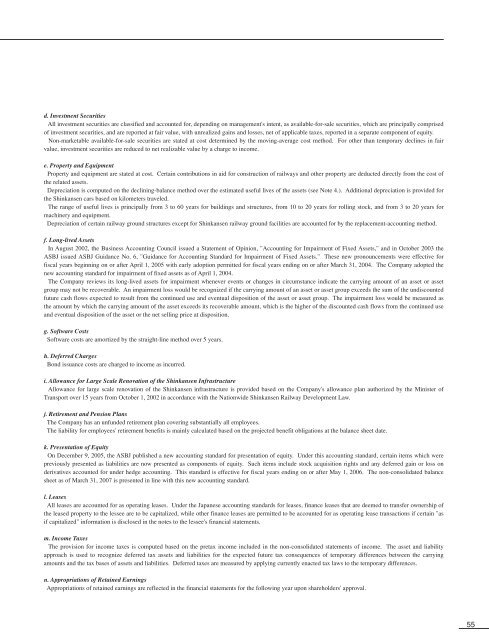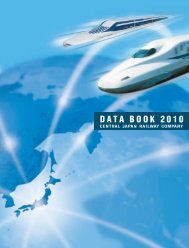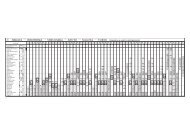CENTRAL JAPAN RAILWAY COMPANY Annual Report 2007
CENTRAL JAPAN RAILWAY COMPANY Annual Report 2007
CENTRAL JAPAN RAILWAY COMPANY Annual Report 2007
You also want an ePaper? Increase the reach of your titles
YUMPU automatically turns print PDFs into web optimized ePapers that Google loves.
d. Investment Securities<br />
All investment securities are classified and accounted for, depending on management's intent, as available-for-sale securities, which are principally comprised<br />
of investment securities, and are reported at fair value, with unrealized gains and losses, net of applicable taxes, reported in a separate component of equity.<br />
Non-marketable available-for-sale securities are stated at cost determined by the moving-average cost method. For other than temporary declines in fair<br />
value, investment securities are reduced to net realizable value by a charge to income.<br />
e. Property and Equipment<br />
Property and equipment are stated at cost. Certain contributions in aid for construction of railways and other property are deducted directly from the cost of<br />
the related assets.<br />
Depreciation is computed on the declining-balance method over the estimated useful lives of the assets (see Note 4.). Additional depreciation is provided for<br />
the Shinkansen cars based on kilometers traveled.<br />
The range of useful lives is principally from 3 to 60 years for buildings and structures, from 10 to 20 years for rolling stock, and from 3 to 20 years for<br />
machinery and equipment.<br />
Depreciation of certain railway ground structures except for Shinkansen railway ground facilities are accounted for by the replacement-accounting method.<br />
f. Long-lived Assets<br />
In August 2002, the Business Accounting Council issued a Statement of Opinion, "Accounting for Impairment of Fixed Assets," and in October 2003 the<br />
ASBJ issued ASBJ Guidance No. 6, "Guidance for Accounting Standard for Impairment of Fixed Assets." These new pronouncements were effective for<br />
fiscal years beginning on or after April 1, 2005 with early adoption permitted for fiscal years ending on or after March 31, 2004. The Company adopted the<br />
new accounting standard for impairment of fixed assets as of April 1, 2004.<br />
The Company reviews its long-lived assets for impairment whenever events or changes in circumstance indicate the carrying amount of an asset or asset<br />
group may not be recoverable. An impairment loss would be recognized if the carrying amount of an asset or asset group exceeds the sum of the undiscounted<br />
future cash flows expected to result from the continued use and eventual disposition of the asset or asset group. The impairment loss would be measured as<br />
the amount by which the carrying amount of the asset exceeds its recoverable amount, which is the higher of the discounted cash flows from the continued use<br />
and eventual disposition of the asset or the net selling price at disposition.<br />
g. Software Costs<br />
Software costs are amortized by the straight-line method over 5 years.<br />
h. Deferred Charges<br />
Bond issuance costs are charged to income as incurred.<br />
i. Allowance for Large Scale Renovation of the Shinkansen Infrastructure<br />
Allowance for large scale renovation of the Shinkansen infrastructure is provided based on the Company's allowance plan authorized by the Minister of<br />
Transport over 15 years from October 1, 2002 in accordance with the Nationwide Shinkansen Railway Development Law.<br />
j. Retirement and Pension Plans<br />
The Company has an unfunded retirement plan covering substantially all employees.<br />
The liability for employees' retirement benefits is mainly calculated based on the projected benefit obligations at the balance sheet date.<br />
k. Presentation of Equity<br />
On December 9, 2005, the ASBJ published a new accounting standard for presentation of equity. Under this accounting standard, certain items which were<br />
previously presented as liabilities are now presented as components of equity. Such items include stock acquisition rights and any deferred gain or loss on<br />
derivatives accounted for under hedge accounting. This standard is effective for fiscal years ending on or after May 1, 2006. The non-consolidated balance<br />
sheet as of March 31, <strong>2007</strong> is presented in line with this new accounting standard.<br />
l. Leases<br />
All leases are accounted for as operating leases. Under the Japanese accounting standards for leases, finance leases that are deemed to transfer ownership of<br />
the leased property to the lessee are to be capitalized, while other finance leases are permitted to be accounted for as operating lease transactions if certain "as<br />
if capitalized" information is disclosed in the notes to the lessee's financial statements.<br />
m. Income Taxes<br />
The provision for income taxes is computed based on the pretax income included in the non-consolidated statements of income. The asset and liability<br />
approach is used to recognize deferred tax assets and liabilities for the expected future tax consequences of temporary differences between the carrying<br />
amounts and the tax bases of assets and liabilities. Deferred taxes are measured by applying currently enacted tax laws to the temporary differences.<br />
n. Appropriations of Retained Earnings<br />
Appropriations of retained earnings are reflected in the financial statements for the following year upon shareholders' approval.<br />
55





